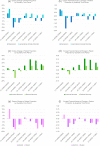Impact of the COVID-19 pandemic on treatment for mental health needs: a perspective on service use patterns and expenditures from commercial medical claims data
- PMID: 36797739
- PMCID: PMC9932413
- DOI: 10.1186/s12913-023-09080-9
Impact of the COVID-19 pandemic on treatment for mental health needs: a perspective on service use patterns and expenditures from commercial medical claims data
Abstract
Objective: To examine changes in use patterns, cost of healthcare services before and after the outbreak of the COVID-19 pandemic, and their impacts on expenditures for patients receiving treatment for depression, anxiety, eating disorders, and substance use.
Methods: This cross-sectional study employed statistical tests to analyze claims in MarketScan® Commercial Database in March 2020-February 2021 and quarterly from March 2020 to August 2021, compared to respective pre-pandemic periods. The analysis is based on medical episodes created by the Merative™ Medical Episode Grouper (MEG). MEG is a methodology that groups medical and prescription drug claims to create clinically relevant episodes of care.
Results: Comparing year-over-year changes, proportion of patients receiving anxiety treatment among all individuals obtaining healthcare services grew 13.7% in the first year of the pandemic (3/2020-2/2021) versus 10.0% in the year before the pandemic (3/2019-2/2020). This, along with a higher growth in price per episode (5.5% versus 4.3%) resulted in a greater increase in per claimant expenditure ($0.61 versus $0.41 per month). In the same periods, proportion of patients receiving treatment for depression grew 3.7% versus 6.9%, but per claimant expenditure grew by same amount due to an increase in price per episode (4.8%). Proportion of patients receiving treatment for anorexia started to increase 21.1% or more in the fall of 2020. Patient proportion of alcohol use in age group 18-34 decreased 17.9% during the pandemic but price per episode increased 26.3%. Patient proportion of opioid use increased 11.5% in March-May 2020 but decreased or had no significant changes in subsequent periods.
Conclusions: We investigated the changes in use patterns and expenditures of mental health patients before and after the outbreak of the COVID-19 pandemic using claims data in MarketScan®. We found that the changes and their financial impacts vary across mental health conditions, age groups, and periods of the pandemic. Some changes are unexpected from previously reported prevalence increases among the general population and could underlie unmet treatment needs. Therefore, mental health providers should anticipate the use pattern changes in services with similar COVID-19 pandemic disruptions and payers should anticipate cost increases due, in part, to increased price and/or service use.
Keywords: COVID-19; Depression; Eating disorders; Healthcare cost; Services utilization; Substance use.
© 2023. The Author(s).
Conflict of interest statement
No.
Figures



Similar articles
-
Impact of COVID-19 on the management of hypertension: a perspective on disease severity, service use patterns and expenditures from Ghana's health insurance claims data.J Hum Hypertens. 2025 Feb;39(2):139-147. doi: 10.1038/s41371-024-00924-3. Epub 2024 Jun 20. J Hum Hypertens. 2025. PMID: 38902509 Free PMC article.
-
Impact of the COVID-19 Pandemic on Medical Expenditures Among Medicare Fee-for-Service Beneficiaries Aged ≥67 Years With Diabetes.Diabetes Care. 2024 Mar 1;47(3):452-459. doi: 10.2337/dc23-1679. Diabetes Care. 2024. PMID: 38227901 Free PMC article.
-
Mental Health Service Utilization Rates Among Commercially Insured Adults in the US During the First Year of the COVID-19 Pandemic.JAMA Health Forum. 2023 Jan 6;4(1):e224936. doi: 10.1001/jamahealthforum.2022.4936. JAMA Health Forum. 2023. PMID: 36607697 Free PMC article.
-
Trends in US Ambulatory Care Patterns During the COVID-19 Pandemic, 2019-2021.JAMA. 2022 Jan 18;327(3):237-247. doi: 10.1001/jama.2021.24294. JAMA. 2022. PMID: 35040886 Free PMC article.
-
Global prevalence and burden of depressive and anxiety disorders in 204 countries and territories in 2020 due to the COVID-19 pandemic.Lancet. 2021 Nov 6;398(10312):1700-1712. doi: 10.1016/S0140-6736(21)02143-7. Epub 2021 Oct 8. Lancet. 2021. PMID: 34634250 Free PMC article.
Cited by
-
Impact of COVID-19 on the management of hypertension: a perspective on disease severity, service use patterns and expenditures from Ghana's health insurance claims data.J Hum Hypertens. 2025 Feb;39(2):139-147. doi: 10.1038/s41371-024-00924-3. Epub 2024 Jun 20. J Hum Hypertens. 2025. PMID: 38902509 Free PMC article.
-
Development of an American and Australian co-designed youth mental health literacy program.Front Child Adolesc Psychiatry. 2023 Jun 1;1:1018173. doi: 10.3389/frcha.2022.1018173. eCollection 2022. Front Child Adolesc Psychiatry. 2023. PMID: 39817280 Free PMC article. Review.
-
Exploring Depression and Nutritional Covariates Amongst US Adults using Shapely Additive Explanations.Health Sci Rep. 2023 Oct 20;6(10):e1635. doi: 10.1002/hsr2.1635. eCollection 2023 Oct. Health Sci Rep. 2023. PMID: 37867784 Free PMC article.
References
-
- Moreno C, Wykes T, Galderisi S, Nordentoft M, Crossley N, Jones N, Cannon M, Correll CU, Byrne L, Carr S, Chen EYH, Gorwood P, Johnson S, Kärkkäinen H, Krystal JH, Lee J, Lieberman J, López-Jaramillo C, Männikkö M, Phillips MR, Uchida H, Vieta E, Vita A, Arango C. How mental health care should change as a consequence of the COVID-19 pandemic. Lancet Psychiatry. 2020;7(9):813–824. doi: 10.1016/S2215-0366(20)30307-2. - DOI - PMC - PubMed
-
- C.S. Mott Children’s Hospital Mott Poll Report. How the pandemic has impacted teen mental health. August 2021. https://mottpoll.org/sites/default/files/documents/031521_MentalHealth.pdf
MeSH terms
LinkOut - more resources
Full Text Sources
Medical

